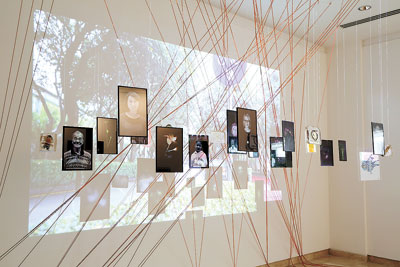
Cao Zhen
caozhen0806@126.com
THIRTEEN artists from Hong Kong, Taiwan, Macao and the mainland are displaying their latest works at the “Conforming to Vicinity” exhibition at the He Xiangning Art Museum.
The exhibition showcases installations, videos, sculptures and photographs and is part of the Four-region Artistic Exchange Project. The multi-region project was initiated by the He Xiangning Art Museum in 2008, with exhibitions held in Shenzhen, Hong Kong, Taiwan and Macao. The project, held annually since 2010, aims to set up a mechanism of exchange between cultures, explore the new state of contemporary art and question how regional culture can influence artistic creation.
This year, the art pieces have already been exhibited in Macao and Pingtung, Taiwan and they will tour to Hong Kong in November after the exhibition closes at the He Xiangning Art Museum on Oct. 26. At every stop, the artists add new elements to their works, adjusting to local cultures and circumstances. Thus, the works carry traces of where they have been on their journey.
“The four regions share Chinese cultural traditions, but because of historical and political factors, the differences between each region emerge in their own ways,” said Feng Boyi, chief curator of the exhibition.
In mainland artist Zhang Wenchao’s animated installation “Fortress Besieged Game,” he has drawn the landmarks and street lanes of Macao, Taiwan and Shenzhen based on his experiences in the three places. The Hong Kong part of his work will be done when the exhibition arrives in Hong Kong.
“This work shows my first impressions of these cities and expresses my understanding of them,” Zhang said. “The characteristics I choose to magnify, such as Macao’s casinos and Taiwan’s tropical plants, are mixed with my personal views on urban ecology and culture.”
The exhibition not only highlights the artists’ understanding and recognition of the four regions, but also displays the similarities and differences of the modern social values in the four regions arising from historical differences.
In Macao artist Carol Kwok’s multimedia installation “Intersection — Blood Lines,” she asked local people from the four regions about their feelings on Shenzhen, Macao, Hong Kong and Taiwan in a video. She uses red threads to represent bloodlines connecting the interviewees’ photos in the exhibition hall.
“Through my research, I have found that the four cities are all largely made up of Chinese people, but they exhibit major differences in culture. My work answers a series of questions on beliefs, culture and self-worth in the different regions,” said Kwok.
Bonnie and Kitty Leung, sister artists from Macao, also display their understanding of the relationships between the four regions. They juxtapose four videos with different cityscapes in the background as a group, illustrating the maritime conditions of the peripheral coastlines of the four regions to show how they are connected by seawater. “The consistency of the sea level in nature symbolizes the inevitable communication, convergence, transformation, integration and coordination among the four regions,” said the Leungs.
While Macao artists emphasize the convergence of the cultures, Hong Kong artists focus more on local urban development. “Hong Kong artists at the exhibition all take land and urban problems as a theme because Hong Kong’s densely packed population makes it different from the other three regions, and Hong Kongers dream of having enough space. At the exhibition, they use new media to display their views on the current state of the four regions,” said Sarah Ng, the Hong Kong curator of the exhibition.
Artist Hung Keung captures on video a morphing ink painting of old streets. The changes in the shades of the ink represent memory and regret as an old neighborhood disappears because of urbanization.
The artists’ interest in seeking the similarities and differences between the four regions can also be seen in the Taiwanese art pieces. In graphic designer Lee Ken-tsai’s interactive installation “Between Sameness and Difference and Between Probability and Improbability,” he invites visitors to participate in games based on their understanding of the linguistic and textual differences of the four regions.
“Text occupies an important position in graphic design,” said Lee. “When I looked at the four regions, my first observation was of the similarities and differences between the cultures as revealed through text or dialect. Although the four regions are different in many ways, such as living habits and leisure activities, similarities and differences intersect and overlap, forming the complex coexistent relationships.”
Dates: Until Oct. 26
Hours: 9:30 a.m.-5 p.m. Closed Mondays
Venue: He Xiangning Art Museum, Overseas Chinese Town, Nanshan District (南山区华侨城何香凝美术馆)
Metro: Luobao Line, OCT Station (华侨城站), Exit C
|

